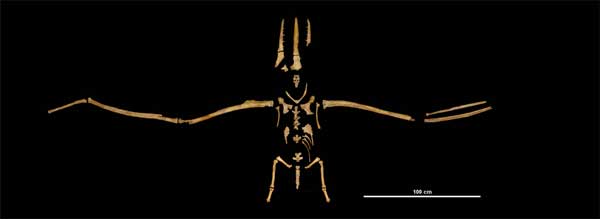Ancient Toothy Bird Had Record Wingspan

A newly discovered skeleton of an ancient seabird has swooped into the record books as having the largest bird wingspan ever: a whopping 17 feet (5.2 meters).
The measurement is the largest confidently established wingspan for a bird, the researchers reported today (Sept. 15) in the Journal of Vertebrate Paleontology. Other contenders for the title of largest wingspan have been based on less secure evidence, they said.
The new skeleton, discovered in northern Chile, is 5 million to 10 million years old. The bird belongs to a group known as "pelagornithids," or, less formally, "bony-toothed birds." They get that name from the spiny, tooth-like projections on their long, slender beaks. The bird probably used those teeth to capture slippery ocean prey like squid and fish. [See an artist's conception of the bony-toothed bird.]
"Although these animals would have looked like creatures from Jurassic Park, they are true birds," lead study author Gerald Mayr of the Forschungsinstitut Senckenberg in Germany said in a statement. "Their last representatives may have coexisted with the earliest humans in North Africa."
Fossils of bony-toothed birds are found on all continents, but the fragile bones are rarely well-preserved. The new specimen, which is 70-percent complete and uncrushed, is the largest bony-toothed bird ever discovered. It also represents a new species named after its country of origin (Chile): Pelagornis chilensis.
Knowledge of the maximum size that can be reached by a flying bird is important for understanding the physics of flight, according to the researchers. The new fossil may therefore help scientists better understand physical and anatomical constraints in very large birds.
Plus, giant toothy predators are just cool, the researchers added.
Get the world’s most fascinating discoveries delivered straight to your inbox.
"Bird watching in Chile would be thrilling if birds with more than 5-meter wingspans and huge pseudo-teeth were still alive," Mayr said.
A life-size reconstruction of the skeleton will be on exhibition in the Senckenberg Museum in Frankfurt am Main, Germany.

